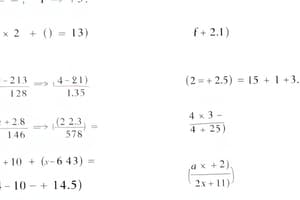Podcast
Questions and Answers
What is the first step in factoring a quadratic trinomial with a = 1?
What is the first step in factoring a quadratic trinomial with a = 1?
- List the pairs of factors of 'a'.
- Identify the coefficient of the x² term.
- Calculate the discriminant of the trinomial.
- Identify the constant term and the coefficient of the x term. (correct)
In factoring x² + 5x + 6, which pair of factors correctly sums to the coefficient of x?
In factoring x² + 5x + 6, which pair of factors correctly sums to the coefficient of x?
- (2, 3) (correct)
- (6, 1)
- (3, 2)
- (1, 6)
When factoring a trinomial where the constant term is negative, what must be true about the signs of the factors?
When factoring a trinomial where the constant term is negative, what must be true about the signs of the factors?
- The factors must have opposite signs. (correct)
- Both factors must be positive.
- The factors can be either positive or negative.
- Both factors must be negative.
What is the factored form of x² - 7x + 12?
What is the factored form of x² - 7x + 12?
Which of the following represents a common error when factoring quadratic trinomials?
Which of the following represents a common error when factoring quadratic trinomials?
If a quadratic trinomial has a positive constant term and a negative coefficient for x, what can be inferred about the signs of its factors?
If a quadratic trinomial has a positive constant term and a negative coefficient for x, what can be inferred about the signs of its factors?
When factoring the quadratic trinomial x² - 8x - 20, which factor pair sums to -8?
When factoring the quadratic trinomial x² - 8x - 20, which factor pair sums to -8?
Flashcards
Factoring a quadratic trinomial (a = 1)
Factoring a quadratic trinomial (a = 1)
In a quadratic trinomial of the form ax² + bx + c, where a = 1, factoring involves finding two numbers (p and q) that multiply to give 'c' (the constant term) and add up to 'b' (the coefficient of the x term). The factored form is then (x + p)(x + q).
What is the constant term in a quadratic trinomial?
What is the constant term in a quadratic trinomial?
The constant term in a quadratic trinomial is the term without any variables, represented by the letter 'c'.
What is the coefficient of the x term in a quadratic trinomial?
What is the coefficient of the x term in a quadratic trinomial?
The coefficient of the x term in a quadratic trinomial is the number multiplying the x variable, represented by the letter 'b'.
Factoring a quadratic trinomial: Positive constant term
Factoring a quadratic trinomial: Positive constant term
Signup and view all the flashcards
Factoring a quadratic trinomial: Negative constant term
Factoring a quadratic trinomial: Negative constant term
Signup and view all the flashcards
Why is factoring quadratic trinomials important?
Why is factoring quadratic trinomials important?
Signup and view all the flashcards
What are common errors when factoring quadratic trinomials?
What are common errors when factoring quadratic trinomials?
Signup and view all the flashcards
What makes factoring quadratic trinomials a key skill?
What makes factoring quadratic trinomials a key skill?
Signup and view all the flashcards
Study Notes
Factoring Quadratic Trinomials (a = 1)
- A quadratic trinomial in the form ax² + bx + c, factors into the form (x + p)(x + q), where a = 1.
- In this case, p and q are the factors of 'c' (the constant term) that add up to 'b' (the coefficient of the x term).
Finding the factors
- Identify the constant term (c) and the coefficient of the x term (b).
- List all possible pairs of factors of 'c'.
- Determine which pair of factors adds up to 'b'. These factors, p and q, become the constants in the factored expression (x + p)(x + q).
Example: Factoring x² + 5x + 6
- Constant term (c) = 6
- Coefficient of x term (b) = 5
- Possible factor pairs of 6: (1, 6), (2, 3), (-1, -6), (-2, -3)
- The pair that sums to 5 is (2, 3).
- Therefore, the factored form is (x + 2)(x + 3).
Example: Factoring x² - 7x + 12
- Constant term (c) = 12
- Coefficient of x term (b) = -7
- Possible factor pairs of 12: (1, 12), (2, 6), (3, 4), (-1, -12), (-2, -6), (-3, -4)
- The pair that sums to -7 is (-3, -4).
- Therefore, the factored form is (x - 3)(x - 4).
Example: Factoring x² + x - 6
- Constant term (c) = -6
- Coefficient of x term (b) = 1
- Possible factor pairs of -6: (1, -6), (2, -3), (-1, 6), (-2, 3)
- The pair that sums to 1 is (3, -2).
- Therefore, the factored form is (x + 3)(x - 2).
Example: Factoring x² - 8x - 20
- Constant term (c) = -20
- Coefficient of x term (b) = -8
- Possible factor pairs of -20: (1, -20), (2, -10), (4, -5), (-1, 20), (-2, 10), (-4, 5)
- The pair that sums to -8 is (-10, 2).
- Therefore, the factored form is (x - 10)(x + 2).
Special Cases
- If the constant term (c) is positive, both factors will have the same sign (either both positive or both negative), and that sign must match the sign of the linear term's coefficient (b).
- If the constant term (c) is negative, the factors must have opposite signs. The larger factor will have the same sign as the coefficient of the linear term (b).
Common Errors and Troubleshooting
- Forgetting to consider negative factors.
- Incorrectly identifying the factors that add up to the coefficient of the middle term.
- Confusing the order of factoring.
- Mistaking the signs of the factors.
Importance of Factoring
- Factoring quadratic trinomials is essential for various mathematical tasks such as solving quadratic equations, simplifying expressions, and performing operations on rational expressions. It's helpful in calculus and beyond.
Studying That Suits You
Use AI to generate personalized quizzes and flashcards to suit your learning preferences.




